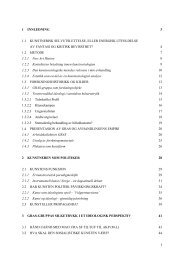2003 Rogaland museum - Gras Katalog - Victor Lind
2003 Rogaland museum - Gras Katalog - Victor Lind
2003 Rogaland museum - Gras Katalog - Victor Lind
You also want an ePaper? Increase the reach of your titles
YUMPU automatically turns print PDFs into web optimized ePapers that Google loves.
Ellen M. Sæthre<br />
GRAS from an Art Historical Perspective<br />
During the early 1970s, the Norwegian artist collective GRAS took form and<br />
disintegrated in a period that spanned four short years. Established in 1970, fourteen<br />
of the group’s members would participate in GRAS’ most recognised group<br />
production, a folder of an equal number of silkscreen prints – one by each participating<br />
member.<br />
The significance of the folder with regards to the question at hand is that it<br />
relates directly to the group’s preferred artistic forms, inspired by both Hard Edge<br />
and Pop art. On the one hand, Bjørn Arne Krogstad’s simple yet striking tricolour<br />
composition Untitled (1971) calls on similar forms found in other Hard Edge inspired<br />
works, while on the other hand and in sharp opposition, Morten Krohg’s Do<br />
you know how to reach the influential Californian market? (1971) recalls Robert<br />
Rauschenberg’s flat, 1960s silkscreen paintings. Within the range of artistic articulations<br />
that these two works present, the notion of the artistic form of GRAS can be<br />
introduced.<br />
It is important to note that to identify the individual productions of the<br />
group as simply one of two borrowed forms is to introduce an idea of GRAS that<br />
lacks an understanding of the individuality of its members, the socio-political foundations<br />
of the group as a whole, and the significant creative freedom that those forms<br />
afforded the GRAS group. Although the members shared some common traits<br />
grounded in the artistic and political radicalism that some of the central members<br />
brought to the group, their diversity found in both form and intention certainly defines<br />
the group as much as it divides them. Anders Kjær, Per Kleiva, Morten Krohg,<br />
<strong>Victor</strong> <strong>Lind</strong>, and Willibald Storn are traditionally brought forth as the central figures<br />
of the group; this idea is not only reinforced by a study of the variety of styles that<br />
these artists brought to the group, but also through insight into their contributions<br />
to the group’s establishment. Where Storn and Kleiva stood behind its establishment<br />
– Storn had the idea, Kleiva had the name – Krohg found the space in which<br />
they could establish their workshop. <strong>Lind</strong>, one of the more politically oriented<br />
artists of the group, developed an aesthetic that, like Kjær’s, expressed their political<br />
interest in the contemporary society – something that proved to be an essential<br />
aspect of GRAS’ interest and work. Politics is not only present as subject matter, it<br />
15



